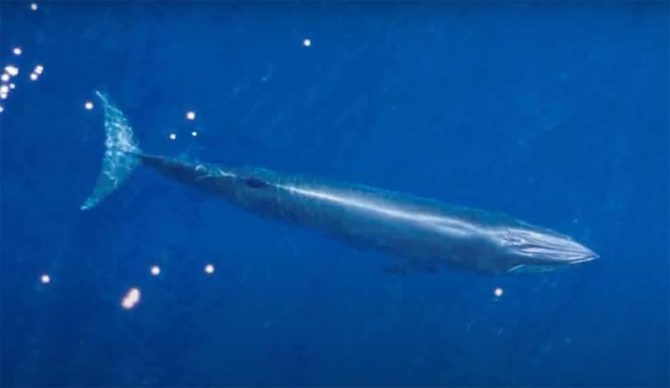
Researchers figured out that the Bryde’s Whales in the Gulf of Mexico were not, in fact, Bryde’s Whales. Photo: NWF
Although we humans certainly do like to think of ourselves as smart, there’s a whole lot about the planet that we don’t know about. Most of those unknowns reside under the surface of the ocean, and in 2021, a new species was discovered there. That’s usually not super interesting — new species are discovered all the time — except this wasn’t just an insect or strange new frog. It was a whole entire whale.
Named the Rice’s whale after Dale Rice, a biologist who was the first to clue into the existence of the giant animal, it is found off the coast of Florida in the Gulf of Mexico (or Gulf of America, now, I guess?), and was first described (the scientific term for being officially given a name) in 2021.
The whole thing started in 2019, when a stranded whale was found off the shores of Everglades National Park. At first, researchers believed they’d found a Bryde’s whale (pronounced “broo-dus,” not “brides”), but soon realized that they were looking at something different.
The animal’s skull led them to ask a few questions, so they decided to test the DNA. The results were surprising: the new whale was decidedly not the same species as the Bryde’s whale. Instead, Rice’s whales appear to live in the Gulf, while Bryde’s whales, although relatively rare, are found in oceans all over the world.
“We joked in the past about nicknaming the Rice’s whale the Gulf’s whale,” said Dr. Alisha Renfro, coastal scientist with the National Wildlife Federation (NWF) who may or may not know the definition of a joke. “They’re only found in the Gulf of Mexico and are one of the most endangered whale species on the planet.”
Aside from the fact that we’ve only just figured out that we’re sharing the planet with a whole new kind of whale, the discovery is interesting because Rice’s whales only live in a tiny part of the world — as far we know, anyway. They spend their lives in the Desoto Canyon, which is a very deep part of the Gulf of Mexico off of Alabama and the Florida Panhandle.
The National Oceanic and Atmospheric Administration (NOAA), however, thinks that they used to be far more spread out. Whaling records from as far back as the 1800s offer what could be considered proof that the Rice’s whale once swam off the northern and southern Gulf of Mexico, possibly as far south as the Bay of Campeche, off the coast of Mexico.
As you’d expect, the Rice’s whale isn’t doing so hot, population-wise. Experts believe there are only 50-100 of them alive today. Looking back in time, those small numbers were made smaller by the devastating BP Oil spill, which caused those numbers to plummet by an estimated 22 percent, according to the NOAA.
“Their prime habitat is located fairly close to the source of the oil in 2010,” Renfro explained. “How much impact it had on the Rice’s whales is hard to tell. Since they’re found in deep water, it’s hard to see or recover bodies.”

